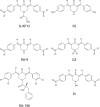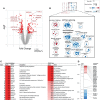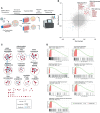Comprehensive Target Screening and Cellular Profiling of the Cancer-Active Compound b-AP15 Indicate Abrogation of Protein Homeostasis and Organelle Dysfunction as the Primary Mechanism of Action
- PMID: 35530310
- PMCID: PMC9076133
- DOI: 10.3389/fonc.2022.852980
Comprehensive Target Screening and Cellular Profiling of the Cancer-Active Compound b-AP15 Indicate Abrogation of Protein Homeostasis and Organelle Dysfunction as the Primary Mechanism of Action
Abstract
Dienone compounds have been demonstrated to display tumor-selective anti-cancer activity independently of the mutational status of TP53. Previous studies have shown that cell death elicited by this class of compounds is associated with inhibition of the ubiquitin-proteasome system (UPS). Here we extend previous findings by showing that the dienone compound b-AP15 inhibits proteasomal degradation of long-lived proteins. We show that exposure to b-AP15 results in increased association of the chaperones VCP/p97/Cdc48 and BAG6 with proteasomes. Comparisons between the gene expression profile generated by b-AP15 to those elicited by siRNA showed that knock-down of the proteasome-associated deubiquitinase (DUB) USP14 is the closest related to drug response. USP14 is a validated target for b-AP15 and we show that b-AP15 binds covalently to two cysteines, Cys203 and Cys257, in the ubiquitin-binding pocket of the enzyme. Consistent with this, deletion of USP14 resulted in decreased sensitivity to b-AP15. Targeting of USP14 was, however, found to not fully account for the observed proteasome inhibition. In search for additional targets, we utilized genome-wide CRISPR/Cas9 library screening and Proteome Integral Solubility Alteration (PISA) to identify mechanistically essential genes and b-AP15 interacting proteins respectively. Deletion of genes encoding mitochondrial proteins decreased the sensitivity to b-AP15, suggesting that mitochondrial dysfunction is coupled to cell death induced by b-AP15. Enzymes known to be involved in Phase II detoxification such as aldo-ketoreductases and glutathione-S-transferases were identified as b-AP15-targets using PISA. The finding that different exploratory approaches yielded different results may be explained in terms of a "target" not necessarily connected to the "mechanism of action" thus highlighting the importance of a holistic approach in the identification of drug targets. We conclude that b-AP15, and likely also other dienone compounds of the same class, affect protein degradation and proteasome function at more than one level.
Keywords: Michael acceptor; b-AP15; dienone; mitochondrial dysfunction; proteasome inhibitor; target screening.
Copyright © 2022 Gubat, Selvaraju, Sjöstrand, Kumar Singh, Turkina, Schmierer, Sabatier, Zubarev, Linder and D’Arcy.
Conflict of interest statement
The authors declare that the research was conducted in the absence of any commercial or financial relationships that could be construed as a potential conflict of interest.
Figures








Similar articles
-
Targeted inhibition of the deubiquitinating enzymes, USP14 and UCHL5, induces proteotoxic stress and apoptosis in Waldenström macroglobulinaemia tumour cells.Br J Haematol. 2015 May;169(3):377-90. doi: 10.1111/bjh.13304. Epub 2015 Feb 17. Br J Haematol. 2015. PMID: 25691154 Free PMC article.
-
A ubiquitinome analysis to study the functional roles of the proteasome associated deubiquitinating enzymes USP14 and UCH37.J Proteomics. 2022 Jun 30;262:104592. doi: 10.1016/j.jprot.2022.104592. Epub 2022 Apr 27. J Proteomics. 2022. PMID: 35489684
-
Targeting proteasomal deubiquitinases USP14 and UCHL5 with b-AP15 reduces 5-fluorouracil resistance in colorectal cancer cells.Acta Pharmacol Sin. 2023 Dec;44(12):2537-2548. doi: 10.1038/s41401-023-01136-0. Epub 2023 Aug 1. Acta Pharmacol Sin. 2023. PMID: 37528233 Free PMC article.
-
Proteasome deubiquitinases as novel targets for cancer therapy.Int J Biochem Cell Biol. 2012 Nov;44(11):1729-38. doi: 10.1016/j.biocel.2012.07.011. Epub 2012 Jul 20. Int J Biochem Cell Biol. 2012. PMID: 22819849 Review.
-
USP14: Structure, Function, and Target Inhibition.Front Pharmacol. 2022 Jan 5;12:801328. doi: 10.3389/fphar.2021.801328. eCollection 2021. Front Pharmacol. 2022. PMID: 35069211 Free PMC article. Review.
Cited by
-
Site-Specific Nanobody Inhibitors of the Proteasomal Deubiquitinase UCH37.bioRxiv [Preprint]. 2025 Aug 13:2025.08.11.669711. doi: 10.1101/2025.08.11.669711. bioRxiv. 2025. PMID: 40832226 Free PMC article. Preprint.
-
Inhibition of USP14 promotes TNFα-induced cell death in head and neck squamous cell carcinoma (HNSCC).Cell Death Differ. 2023 May;30(5):1382-1396. doi: 10.1038/s41418-023-01144-x. Epub 2023 Apr 13. Cell Death Differ. 2023. PMID: 37055579 Free PMC article.
-
Treatment with b-AP15 to Inhibit UCHL5 and USP14 Deubiquitinating Activity and Enhance p27 and Cyclin E1 for Tumors with p53 Deficiency.Technol Cancer Res Treat. 2022 Jan-Dec;21:15330338221119745. doi: 10.1177/15330338221119745. Technol Cancer Res Treat. 2022. PMID: 35971329 Free PMC article.
-
Ubiquitin-Specific Protease Inhibitors for Cancer Therapy: Recent Advances and Future Prospects.Biomolecules. 2025 Feb 7;15(2):240. doi: 10.3390/biom15020240. Biomolecules. 2025. PMID: 40001543 Free PMC article. Review.
-
Loss of the proteasomal deubiquitinase USP14 induces growth defects and a senescence phenotype in colorectal cancer cells.Sci Rep. 2024 Jun 6;14(1):13037. doi: 10.1038/s41598-024-63791-5. Sci Rep. 2024. PMID: 38844605 Free PMC article.
References
LinkOut - more resources
Full Text Sources
Molecular Biology Databases
Research Materials
Miscellaneous

